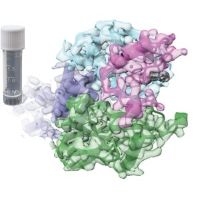Specification
| Description | Recombinant protein from the full-length sequence of Homo sapiens checkpoint kinase 1 (CHEK1), transcript variant 1 (NM_001114122). |
| Organism | Homo sapiens (Human) |
| Expression Host | Human Cells |
| Tag Info | His or DYKDDDDK. Please contact us if you need further information or require specific designed tag. |
| Purity | Greater than 90% by SDS-PAGE gel |
| Uniprot ID | O14757 |
| Entry Name | CHK1_HUMAN |
| Gene Names | CHEK1 CHK1 |
| Alternative Gene Names | CHK1 |
| Alternative Protein Names | Serine/threonine-protein kinase Chk1 (EC 2.7.11.1) (CHK1 checkpoint homolog) (Cell cycle checkpoint kinase) (Checkpoint kinase-1) |
| Application | Antigens, Western, ELISA and other in vitro binding or in vivo functional assays, and protein-protein interaction studies; For research & development use only! |
| Buffer | Purified protein formulated in a sterile solution of PBS buffer, pH7.2, without any preservatives |
| Endotoxin | Endotoxin level is < 0.1 ng/µg of protein (<1EU /µg) |
| Length | 476 |
| Molecular Weight(Da) | 54434 |
| Protein Sequence | (The sequence of expressed protein may have some variation from the sequence shown below. Please contact us for the exact sequence.) MAVPFVEDWDLVQTLGEGAYGEVQLAVNRVTEEAVAVKIVDMKRAVDCPENIKKEICINKMLNHENVVKFYGHRREGNIQYLFLEYCSGGELFDRIEPDIGMPEPDAQRFFHQLMAGVVYLHGIGITHRDIKPENLLLDERDNLKISDFGLATVFRYNNRERLLNKMCGTLPYVAPELLKRREFHAEPVDVWSCGIVLTAMLAGELPWDQPSDSCQEYSDWKEKKTYLNPWKKIDSAPLALLHKILVENPSARITIPDIKKDRWYNKPLKKGAKRPRVTSGGVSESPSGFSKHIQSNLDFSPVNSASSEENVKYSSSQPEPRTGLSLWDTSPSYIDKLVQGISFSQPTCPDHMLLNSQLLGTPGSSQNPWQRLVKRMTRFFTKLDADKSYQCLKETCEKLGYQWKKSCMNQVTISTTDRRNNKLIFKVNLLEMDDKILVDFRLSKGDGLEFKRHFLKIKGKLIDIVSSQKIWLPAT |
Background
| Function | FUNCTION: Serine/threonine-protein kinase which is required for checkpoint-mediated cell cycle arrest and activation of DNA repair in response to the presence of DNA damage or unreplicated DNA (PubMed:11535615, PubMed:12446774, PubMed:12399544, PubMed:14559997, PubMed:14988723, PubMed:15311285, PubMed:15665856, PubMed:15650047, PubMed:32357935). May also negatively regulate cell cycle progression during unperturbed cell cycles (PubMed:11535615, PubMed:12446774, PubMed:12399544, PubMed:14559997, PubMed:14988723, PubMed:15311285, PubMed:15665856, PubMed:15650047). This regulation is achieved by a number of mechanisms that together help to preserve the integrity of the genome (PubMed:11535615, PubMed:12446774, PubMed:12399544, PubMed:14559997, PubMed:14988723, PubMed:15311285, PubMed:15665856, PubMed:15650047). Recognizes the substrate consensus sequence [R-X-X-S/T] (PubMed:11535615, PubMed:12446774, PubMed:12399544, PubMed:14559997, PubMed:14988723, PubMed:15311285, PubMed:15665856, PubMed:15650047). Binds to and phosphorylates CDC25A, CDC25B and CDC25C (PubMed:9278511, PubMed:12676583, PubMed:14681206, PubMed:12676925, PubMed:12759351, PubMed:19734889, PubMed:14559997). Phosphorylation of CDC25A at 'Ser-178' and 'Thr-507' and phosphorylation of CDC25C at 'Ser-216' creates binding sites for 14-3-3 proteins which inhibit CDC25A and CDC25C (PubMed:9278511). Phosphorylation of CDC25A at 'Ser-76', 'Ser-124', 'Ser-178', 'Ser-279' and 'Ser-293' promotes proteolysis of CDC25A (PubMed:9278511, PubMed:12676583, PubMed:14681206, PubMed:12676925, PubMed:12759351, PubMed:19734889). Phosphorylation of CDC25A at 'Ser-76' primes the protein for subsequent phosphorylation at 'Ser-79', 'Ser-82' and 'Ser-88' by NEK11, which is required for polyubiquitination and degradation of CDCD25A (PubMed:9278511, PubMed:19734889, PubMed:20090422). Inhibition of CDC25 leads to increased inhibitory tyrosine phosphorylation of CDK-cyclin complexes and blocks cell cycle progression (PubMed:9278511). Also phosphorylates NEK6 (PubMed:18728393). Binds to and phosphorylates RAD51 at 'Thr-309', which promotes the release of RAD51 from BRCA2 and enhances the association of RAD51 with chromatin, thereby promoting DNA repair by homologous recombination (PubMed:15665856). Phosphorylates multiple sites within the C-terminus of TP53, which promotes activation of TP53 by acetylation and promotes cell cycle arrest and suppression of cellular proliferation (PubMed:10673501, PubMed:15659650, PubMed:16511572). Also promotes repair of DNA cross-links through phosphorylation of FANCE (PubMed:17296736). Binds to and phosphorylates TLK1 at 'Ser-743', which prevents the TLK1-dependent phosphorylation of the chromatin assembly factor ASF1A (PubMed:12660173, PubMed:12955071). This may enhance chromatin assembly both in the presence or absence of DNA damage (PubMed:12660173, PubMed:12955071). May also play a role in replication fork maintenance through regulation of PCNA (PubMed:18451105). May regulate the transcription of genes that regulate cell-cycle progression through the phosphorylation of histones (By similarity). Phosphorylates histone H3.1 (to form H3T11ph), which leads to epigenetic inhibition of a subset of genes (By similarity). May also phosphorylate RB1 to promote its interaction with the E2F family of transcription factors and subsequent cell cycle arrest (PubMed:17380128). Phosphorylates SPRTN, promoting SPRTN recruitment to chromatin (PubMed:31316063). Reduces replication stress and activates the G2/M checkpoint, by phosphorylating and inactivating PABIR1/FAM122A and promoting the serine/threonine-protein phosphatase 2A-mediated dephosphorylation and stabilization of WEE1 levels and activity (PubMed:33108758). {ECO:0000250|UniProtKB:O35280, ECO:0000269|PubMed:10673501, ECO:0000269|PubMed:11535615, ECO:0000269|PubMed:12399544, ECO:0000269|PubMed:12446774, ECO:0000269|PubMed:12660173, ECO:0000269|PubMed:12676583, ECO:0000269|PubMed:12676925, ECO:0000269|PubMed:12759351, ECO:0000269|PubMed:12955071, ECO:0000269|PubMed:14559997, ECO:0000269|PubMed:14681206, ECO:0000269|PubMed:14988723, ECO:0000269|PubMed:15311285, ECO:0000269|PubMed:15650047, ECO:0000269|PubMed:15659650, ECO:0000269|PubMed:15665856, ECO:0000269|PubMed:16511572, ECO:0000269|PubMed:17296736, ECO:0000269|PubMed:17380128, ECO:0000269|PubMed:18451105, ECO:0000269|PubMed:18728393, ECO:0000269|PubMed:19734889, ECO:0000269|PubMed:20090422, ECO:0000269|PubMed:31316063, ECO:0000269|PubMed:32357935, ECO:0000269|PubMed:33108758, ECO:0000269|PubMed:9278511}.; FUNCTION: [Isoform 2]: Endogenous repressor of isoform 1, interacts with, and antagonizes CHK1 to promote the S to G2/M phase transition. {ECO:0000269|PubMed:22184239}. |
| Pathway | |
| Protein Families | Protein kinase superfamily, CAMK Ser/Thr protein kinase family, NIM1 subfamily |
| Tissue Specificity | Expressed ubiquitously with the most abundant expression in thymus, testis, small intestine and colon. {ECO:0000269|PubMed:9278511, ECO:0000269|PubMed:9382850}. |
QC Data
| Note | Please contact us for QC Data |
| Product Image (Reference Only) |  |

